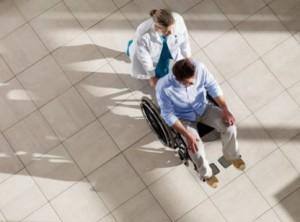Paralytic stroke - Treatment and Rehabilitation after attack:
 If you or your loved one has suffered a paralysis attack then you might know that it can be a very disheartening prognosis. But there is a way to rehabilitate and make your loved one more self-sufficient. Here is a post on treating and rehabilitating a paralysed patient.
If you or your loved one has suffered a paralysis attack then you might know that it can be a very disheartening prognosis. But there is a way to rehabilitate and make your loved one more self-sufficient. Here is a post on treating and rehabilitating a paralysed patient.
Treating paralysis
Unfortunately, there is no cure for permanent paralysis till date. Treatment in such cases is actually mostly rehabilitation which helps the person to adapt to the compromised life and to become as independent as possible with the help of aids. It also aims to correct the complications such as pressure ulceration (ulcers which arise due to a static position on the bed that arise from paralysis).
Hypokalemic periodic paralysis is an inherited disorder in which a person has episodes of muscle weakness and sometimes severe paralysis. Treatment is given to relieve symptoms and prevent further attacks. Potassium helps prevent an attack and is either orally or, in severe cases, intravenously administered. A medicine called acetazolamide prevents attacks in many cases. Triamterene or spironolactone may help prevent attacks in people who do not respond to acetazolamide. A study from California suggested that Topiramate is also effective in cases of children.
Read more about causes, symptoms, diagnosis and treatment of paralysis.
Advances in surgical management of facial paralysis include artificial muscles for eyelid reconstruction, dynamic muscle transfer for the eye, and orthodromic temporalis tendon transfer, as found by the Hopkins researchers in their review.
‘Acupuncture and moxibustion therapy can relieve spastic paralysis after stroke, with better therapeutic effect and no side-effects, but clinical and mechanism studies are still needed,’ say researchers from China. (Read: 10 conditions that ail the elderly)
Mobility aids
Wheelchair and walkers
Wheelchair is a mobility aid and it can be manual or electric. There are a few modified versions such as folding wheelchairs, motorised wheelchairs, light weight wheelchairs with split frame chassis, and other more developed versions.
A new type of wheelchair is available these days (in India as well) that has a seating and positioning measurement analysis system which captures seat and back pressure distribution and contact area. Called ‘Conformat System’, this conforming sensor helps reduce ‘hammock-ing’ and reduces the incidence of ulceration and tissue deterioration.
There is another type of wheelchair called ‘standing chair’ which allows the person to rise to a standing position. This type of wheelchair too reduces the risk of pressure sores.
The walkers too are nowadays available with wheels. This type of walker helps the person to walk without lifting the walker. (Read:International Day of People with Disabilities: How inclusive and accessible is our society?)
Prosthetics and orthoses
Orthoses are external mechanical devices which support, prevent, correct and assist body segments in neuromuscular skeletal conditions.
Prosthesis is a device that replaces or extends a limb, extremity, or other body part.
Researchers are working on systems that achieve muscle contraction through functional electrical stimulation (FES) that effectively allow patients with quadriplegia to regain control of hand movements and to achieve a greater measure of independence in daily activities. The Northwestern University researchers have developed a neuroprosthesis based on FES system that is controlled by recordings made from microelectrodes permanently implanted in the brain. They have successfully tested it on lab monkeys.
Medication and aids for managing paralysis
In most cases, spinal cord injury and paralysis result in the loss of normal bowel and bladder function. So, a catheter is used to empty urine from the bladder. Bowel retraining, enemas, and sometimes colostomy (surgery of the bowel) are done to help people with paralysis empty their bowel.
Pain caused by nerve damage is normally relieved through medicines such as amitriptyline or pregabalin, since common painkillers like paracetamol or ibuprofen are ineffective in such type of pain.
Breathing difficulties that arise through spinal cord injury to the upper neck is often treated using positive pressure ventilators that are either invasive or non-invasive.
For abnormally stiff muscles (spasticity) and involuntary muscle spasms, treatment involves use of muscle relaxants such as Baclofen, Tizanidine or Dantrolene. Sometimes, Botox is given for localised spasms.
A relatively new treatment for management of spastic paralysis is the intrathecalbaclofen (ITB) therapy in which consistent optimal dosage of Baclofen is delivered via a programmable drug pump implanted in the fluid-filled space around the spinal cord. Success of this therapy was reported from the Apollo Hospital, Kolkata, where Dr Anirbandeep Banerjee and his team performed this procedure on a 63-year-old paralytic man who did not respond to other treatments.
‘The patient responded positively when we tried the therapy right from the beginning. Within two weeks of surgery, he was able to get off the bed and sit on a chair without any support. This rapid improvement in the patient is a real bonus for us,’ said Banerjee.
With all these aids and treatments, it has become easier to manage paralysis and live a quality life. However, it is important to note that pressure ulcers can develop if a person is unable to move regularly due to paralysis. Care must be taken to ensure that preventive measures such as changing position regularly or pressure relieving devices are used. It is also important to exercise regularly and stay fit. Your physiotherapist will recommend the exercises and activities.
No comments:
Post a Comment